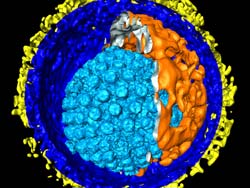Insights into a Virus Proteome

Herpesvirus<br>
The genome encodes the complete information needed by an organism, including that required for protein production. Viruses, which are up to a thousand times smaller than human cells, have considerably smaller genomes.
Using a type of herpesvirus as a model system, the scientists of the Max Planck Institute (MPI) of Biochemistry in Martinsried near Munich and their collaboration partners at the University of California in San Francisco have shown that the genome of this virus contains much more information than previously assumed.
The researchers identified several hundred novel proteins, many of which were surprisingly small. The results of the study have now been published in Science.
More than 80 percent of the world’s population is infected with the herpesvirus, which can cause severe diseases in newborns and in persons with weakened immune system. Researchers had already sequenced the herpesvirus genome 20 years ago, thinking they could then predict all proteins that the virus produces (virus proteome). Now scientists from the research department of Matthias Mann, director at the MPI of Biochemistry, and their American colleagues have analyzed the information content of the genome more precisely.
Small but highly complex
To carry out their study, the scientists infected cells with herpesvirus and observed which proteins the virus produced inside the cell over a period of 72 hours. In order for proteins to be produced at all, the cell machinery must first make copies of the genetic material as intermediate products (RNA). While investigating the intermediate products of the herpesvirus, the American collaborators discovered many novel RNA molecules which were in large part surprisingly short. They also found that the organization of information required for protein production in the virus genome was far more complex than previously assumed. Annette Michalski, a scientist in the Department of Proteomics and Signal Transduction at the MPI of Biochemistry, was subsequently able to confirm directly the predicted viral proteins in the infected cell using mass spectrometry. This method enables an overview of the complete proteome of the virus-infected cell.
The results of the American and German researchers provide detailed insight into the complex mechanisms used by the virus. “We showed that it’s not enough merely to know the virus genome to understand the biology of the herpesvirus,” Annette Michalski said. “What is important is to look at the products actually produced from the genome.” Even human genes may be much more complex than the genome sequence itself indicates, commented the researchers. Matthias Mann and his colleagues plan to investigate this question further in the coming years.
Original publication:
N. Stern-Ginossar , B. Weisburd, A. Michalski, V. T. Khanh Le, M. Y. Hein, S.-X. Huang, M. Ma, B. Shen, S.-B. Qian, H. Hengel, M. Mann, N. T. Ingolia, J. S. Weissmann: Decoding Human Cytomegalovirus, Science, November 23, 2012.
DOI:10.1126/science.1227919
Contact:
Prof. Dr. Matthias Mann
Proteomics and Signal Transduction
Max Planck Institute of Biochemistry
Am Klopferspitz 18
82152 Martinsried
Germany
e-mail: mmann@biochem.mpg.de
www.biochem.mpg.de/mann
Anja Konschak
Public Relations
Max Planck Institute of Biochemistry
Am Klopferspitz 18
82152 Martinsried
Germany
Phone: +49 89 8578-2824
e-mail: konschak@biochem.mpg.de
Further information:
http://www.biochem.mpg.de/en/news/pressroom/086_Mann_HCMV.html
http://www.biochem.mpg.de/mann
(Research Department Proteomics and Signal Transduction)
http://weissmanlab.ucsf.edu/
Hompage of Weissmann Lab at UCSF)
Media Contact
More Information:
http://www.biochem.mpg.deAll latest news from the category: Life Sciences and Chemistry
Articles and reports from the Life Sciences and chemistry area deal with applied and basic research into modern biology, chemistry and human medicine.
Valuable information can be found on a range of life sciences fields including bacteriology, biochemistry, bionics, bioinformatics, biophysics, biotechnology, genetics, geobotany, human biology, marine biology, microbiology, molecular biology, cellular biology, zoology, bioinorganic chemistry, microchemistry and environmental chemistry.
Newest articles

Properties of new materials for microchips
… can now be measured well. Reseachers of Delft University of Technology demonstrated measuring performance properties of ultrathin silicon membranes. Making ever smaller and more powerful chips requires new ultrathin…

Floating solar’s potential
… to support sustainable development by addressing climate, water, and energy goals holistically. A new study published this week in Nature Energy raises the potential for floating solar photovoltaics (FPV)…

Skyrmions move at record speeds
… a step towards the computing of the future. An international research team led by scientists from the CNRS1 has discovered that the magnetic nanobubbles2 known as skyrmions can be…





















